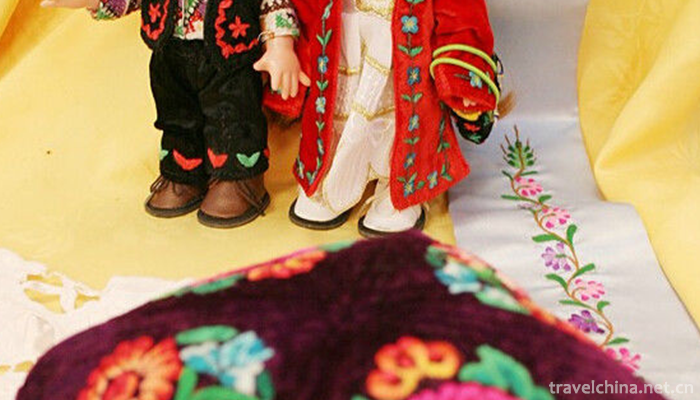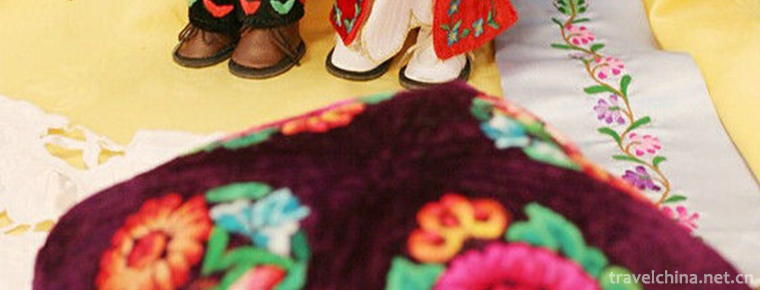Uygur Embroidery
Uygur Embroidery
Embroidery is one of the most representative decorative techniques in Uygur costumes in China. Whether it is Uygur clothes, skirts, shoes, hats and beds, the interior decorative articles adorn the exquisite embroidery of Uygur women. Uygur embroidery has accepted both the inland embroidery technology and the characteristics of its own nation, and gradually formed its own unique charm. Patterns or color matching, with strong national characteristics. It is a kind of technology that punctures the fabric with needle-piercing and thread-piercing, and organizes the lines into patterns by carrying needles according to the design pattern. It is an art that uses needles and thread to complete the pattern.
In 2008, the Uygur embroidery declared by Hami District of Xinjiang Uygur Autonomous Region was listed in the second batch of national intangible cultural heritage list with the approval of the State Council.
Historical Origin
Hami Uygur embroidery is a traditional handicraft to beautify clothes. It is the main and most common decorative method of Hami Uygur traditional clothes. It has unique charm with its complicated style and exquisite embroidery. It is a hard-working Hami Uygur women and the Uygur people have attached great importance to the embroidery technology of clothes for a long time, and it has always been regarded as an indispensable part of clothes. It should be developed and perfected to make it a unique art form of dress decoration commonly used by Uygur people. Hami Uygur traditional clothing embroidery is mainly clothing and accessories, such as gowns, shoulders, long skirts, pants, boots and hats, dozens of kinds. In the history of development and evolution, the continuous integration of various national cultures has greatly developed the Hami Uygur folk embroidery technology and gradually formed a variety of styles and characteristics of different embroidery techniques.
artistic characteristics
As a member of the family of the Chinese nation, the Uygur nationality, like other nationalities in the motherland, has formed its own distinctive national culture in the long process of historical development. In today's global economic integration, it is particularly important to maintain the regional folk culture tradition. Uygur embroidery technology, along with the Uygur people's Millennium culture, has continued to this day. With its strong national characteristics and exquisite crafts, it radiates its unique charm and is unique in the traditional folk crafts of ethnic minorities in Xinjiang. The study of Uygur embroidery technology is helpful to understand the cultural influence factors and artistic value of Uygur embroidery technology, so as to have a deeper understanding of Uygur folk traditional handicraft culture.
Current situation of inheritance
On the basis of actively promoting traditional embroidery art and combining with modern management concept, Aga Khan, the inheritor of Hui folk embroidery in Hami city, set up embroidery factories to make embroidery with national cultural characteristics go to the whole country and the world.
In the exhibition room of Afghan handicraft embroidery, there are not only her own works, but also the handicraft left by her ancestors.
"This is my grandmother's embroidered flower, this is my mother's embroidered flower, this is my own made flower," Agathan Samaiti said.
In Uygur folk, painting, paper-cut and embroidery are in the same vein. Agahan Saimati, a farmer painter from Hami city, is the fourth generation of family embroidery. Her grandmother was an embroidery worker in Hami's Royal palace. Hami Uygur embroidery integrated the skills of Beijing embroidery and Su embroidery. The images of peony, chrysanthemum and dragon appear in embroidery patterns. Agathan Samaiti began to learn paper-cut, embroidery and painting at the age of 7. As a minority peasant woman, her works mainly show the life of peasants. Spring sowing, which won the first prize in the 1988 National Farmers'Painting and Calligraphy Exhibition, is a work of expressing rural life. With the development of the times, more and more peasant embroidery products begin to be recognized by the society and accepted by the public. People like peasant embroidery products because it emits a simple fragrance. Land is the life of peasants, and works are peasants'dreams. There are works in life and life in works. They hold embroidery products with true feelings in their hands, hang them on the wall, see them in their eyes and enjoy themselves in their hearts. While conveying beauty, they also share the happiness of life with more people.
Inheritance Significance
Uygur embroidery technology has remarkable inheritance and blending, which also contains rich cultural anthropological information. The great differences between the natural environment and social conditions of Uygur people make the embroidery techniques of Uygur people in different areas of Xinjiang have different regional characteristics. In the long history of development, Uygur embroidery technology has formed its own unique style, which carries heavy traditional culture and national spirit, and embodies the brilliant material civilization of Uygur. To promote and expand and enrich the research of Uygur embroidery technology in modern design has a certain practical significance for enriching the modern process design system. The study of Uygur embroidery technology as a carrier of national culture can help us better protect and inherit national culture and protect the diversity of human culture in the era of globalization.


-
1.Lingwu Shuidonggou Tourist Area
Shuidonggou Ancient Human Culture Site is located in Shuidonggou Village, Linhe Town, Linwu City, Ningxia. It is 30 kilometers south of Lingwu City, 19 kilometers west of Yinchuan City
Time 2018-12-12 -
2.Liu Sanjie s Grand View Garden
Liu Sanjie Grand View Garden, formerly known as Guilin Liu Sanjie Landscape Garden, is located on the Peach Blossom River in Guilin City, Guangxi Zhuang Autonomous Region. It covers an area of more th
Time 2018-12-26 -
3.Subashi Buddhist Temple Site
Subashi Buddhist Temple Site , also known as Zhaohuili Temple, is located in the south foot of the Queletag Mountains in the northeast of Kuqa County, Xinjiang. It is a national key
Time 2019-02-13 -
4.Xiangshi Zoo
Xiangshi Zoo is invested and constructed by Dongguan Yuye World Industrial Investment Co., Ltd. The total investment of the project is estimated to be 350 million yuan.
Time 2019-02-25 -
5.Old soup essence formula
The formulation of Royal Food Old Tangjing includes the formulation and production technology of Old Tangjing, which is a valuable cultural treasure in the history of condiment development in China. T
Time 2019-05-11 -
6.Manchu Ergui wrestling
Ergui wrestling is a traditional Manchu folk dance spread in the urban and rural areas of Longhua County, Hebei Province. It was formed in the late Qing Dynasty (around 1820 A.D.) and flourished betwe
Time 2019-05-17 -
7.Miao Lusheng Production Techniques
Miao Lusheng production process is complex, generally using scraping, cutting, through, hammering, clamping, drilling and other related tools, through the selection of materials, baking materials, mak
Time 2019-06-05 -
8.Sama Dance
Sama dance is a kind of folk dance that the Uygur working people dance together during the New Year's Festival. Its movements are simple and powerful. It is mainly popular in Kashgar and Shache of Sou
Time 2019-06-12 -
9.Construction Techniques of Tujia Diaojiao Building
Tujia hanging-feet building construction skills, Hubei Xianfeng County, Hunan Yongshun County, Chongqing Shizhu Tujia Autonomous County, local traditional skills, one of the national intangible cultur
Time 2019-06-23 -
10.Neutralization Festival
Zhonghe Festival, a traditional Chinese folk festival, is on the second day of February, but the date at that time was on the first day of February. With the evolution of history, it was changed to th
Time 2019-08-03 -
11.Wawushan National Forest Park
Wawushan National Forest Park is located in Hongya County, Meishan City, west of Sichuan Basin. It is 180 kilometers away from Chengdu and 100 kilometers away from Leshan. As of 1993, the park covers an area of 65869.80 hectares, rich in vegetation resources
Time 2020-10-15 -
12.Education in Neijiang
By the end of 2019, there are 1170 schools at all levels in Neijiang City, with 570100 students and 39400 teaching staff. There are 689 kindergartens with 88900 students; 274 primary schools with 205400 students; 137 junior high schools with 126400 students;
Time 2020-12-16